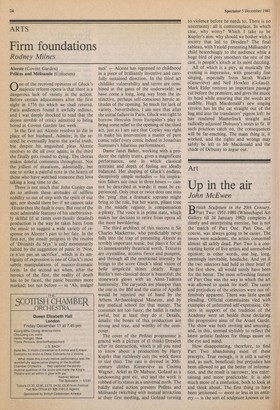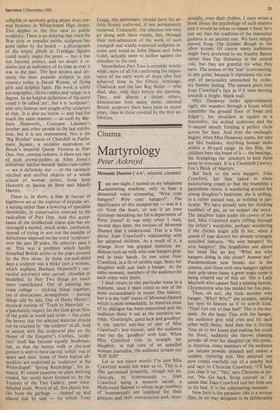Art
Up in the air
John McEwen
British Sculpture in the 20th Century, Part Two: 1951-1980 (Whitechapel Art Gallery till 24 January 1982) completes a timely and enterprising exercise, but is not the match of Part One. Part One, of course, was always going to be easier. The issues were academic, the artists concerned almost all safely dead. Part Two is a contrasting kettle of live artists and unresolved opinion; in other words, one big, long, seemingly inevitable, headache. And yet if the twc selectors had held to their brief of the first show, all would surely have been for the better. The most refreshing feature of Part One was the way in which the art was allowed to speak for itself. The tastes and prejudices of the selectors were not offensively apparent. There was little special pleading. Official commissions vied with examples of unfettered self-expression. Objects in support of the tradition of the Academy were set beside those declaring the progressive aims of the Avant Garde. The show was both inviting and amusing; and, in this, seemed stylishly to reflect the latest artistic fashion for things easier on the eye and mind.
How disappointing, therefore, to find Part Two abandoning most of these precepts. True enough, it is still a survey and, as such, beneficial; but prejudice has been allowed to get the better of information, and the result is narrower, less entertaining and more predictable. It is also much more of a confusion, both to look at and think about. The first thing to have been jettisoned — more or less in its entirety — is the sort of sculpture known or in telligible to anybody going about their normal business in Whitechapel High Street. This applies in the first case to public sculpture. There is no denying that since the War civic or populist public sculpture has gone rather by the board — a photograph of the empty plinth in Trafalgar Square could neatly make the point — but it has not become extinct; and no doubt it remains just as indicative of its time as ever it was in the past. The best known and certainly the most popular sculptor in this country today is David Wynne, of flying girls and dolphin fame. His work is softly pornographic, cliché-ridden and vulgar to a degree. In no helpful definition of the word could it be called 'art', but it is 'sculpture'; and very famous and sought-after sculpture at that. It is also no worse — and bad for much the same reasons — as stuff by Barbara Hepworth, Constant Lambert's brother and other people in the last exhibition, but it is not represented. Nor is the 'Big Brother' statue of Churchill in Parliament Square, a socialist equivalent of Brock's imperial Queen Victoria in Part One. Nor, coming indoors, is there any sign of such crowd-pullers as Allen Jones's notorious leather-booted ladies-cum-tables — sex is definitely out — or the variously stitched and stuffed objects of a whole school of women artists, from Jann Haworth to Saskia de Boer and Mandy Havers.
There is, in short, a bias in favour of highbrow art at the expense of popular art, a raising rather than a lowering of specialist thresholds, in conservative contrast to the radicalism of Part One. And this acceptance of the intellectual status quo has encouraged a second, much wider, confusion: instead of trying to sort out the muddle of definitions imposed on the word 'sculpture' over the past 20 years, the selectors pass it on. This was a problem which hardly disturbed British artists in the years covered by the first show. In those cut-and-dried days a sculptor was a bloke (not a woman, which explains Barbara Hepworth's successful notoriety) who carved, chiselled or modelled. In Part Two things are much more complicated. Out of painting has come collage — sticking things together; out of abstraction, arrangement — putting things side by side. Out of Henry Moore's mystical notions of 'Truth to Materials' — a pantheistic respect for the God-given flow of the grain in woOd and stone — has come the heresy that the selected material should not be touched by 'the sculptor' at all. And in unison with this sculptural play on the theme of the Emperor's Clothes, 'sculpture' itself has become equally insubstantial, so that the merest walk or physical gesture is seen to have carved 'solids' out of space and time. Some of these logical absurdities are enshrined as 'sculpture' at the Whitechapel: 'Spring Recordings', for instance, 81 sound cassettes on glass shelving owned, but surely never listened to, by the Trustees of the Tate Gallery, poor oncedeluded souls. Worst of all, five plastic bottles from the garbage — cleaned up and placed side by side — for which Tony Cragg, the defendant, should have his artistic licence endorsed, if not permanently removed. Unhappily, the selectors not only go along with these trends, but, through their non-admission of the work of such youngish and widely respected sculptors in stone and wood as John Maine and John Cobb, actually seem to incline against the chisellers in the end.
Nevertheless Part Two is certainly worthwhile, most of all for confirming the importance of the early work of those who first achieved fame in the Fifties: Armitage, Chadwick and the late Reg Butler — who died, alas, only days before the opening. They, and almost a dozen others, demonstrate how many more, talented British sculptors there have been in recent years, than in those covered by the first exhibition.











































 Previous page
Previous page